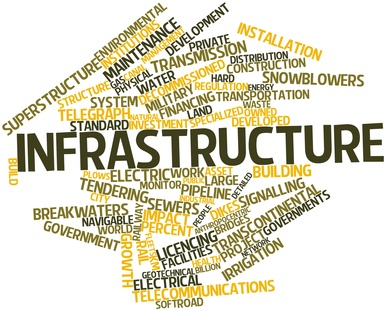Markets get hot for different reasons and if you can get in front of a rising market, it can be a lot of fun.
But when the tide of hot money rolls back out, does your market have a solid foundation for stability and recovery?
It’s an important question. So we decided to dedicate this episode of The Real Estate Guys™ radio show to one of the most important foundations of a solid real estate market: infrastructure.
Behind the shiny microphones to talk about the role of infrastructure in real estate market analysis:
- Your stable host, Robert Helms
- His recovering co-host, Russell Gray
Money moves in and out of all markets, both paper and real, for two basic reasons: momentum and/or fundamentals.
A postmortem of those formerly hot markets which dropped precipitously in the 2008 crash tells us that there was a lot of hot money chasing momentum (speculation). And when the hot money stopped flowing in, prices fell all the way past fundamental levels.
This is a very simplistic explanation, because the real estate bubble was really rooted in hot money in the bond market which fed the real estate market. But the concept is that more properties were built and purchased than there were fundamental reasons for building and owning them.
The result, of course, was inflated prices and overbuilding. And when the tide shifted, prices fell. In some cases, prices fell well below replacement costs (a fundamental).
But some markets fell further than others. And some markets came back sooner than others.
So what makes the difference between a slow falling or fast recovering market, and those that die and never or very slowly come back?
This is an obviously complex question, but one of the key components to a more stable and better recovering market is infrastructure.
 In basic terms, infrastructure is all of the things that need to exist to support human occupation of land. These things include roads, airports, utilities, etc.
In basic terms, infrastructure is all of the things that need to exist to support human occupation of land. These things include roads, airports, utilities, etc.
In broader terms, infrastructure that is attractive to residents and businesses include education, health care, entertainment, shopping, communications and in some cases, shipping.
When you think about it, it makes perfect sense. After all, people and the businesses which employ them need infrastructure in order to live, work and recreate.
Therefore, it stands to reason that, all things being equal (taxes, cost of living, weather), a market with superior infrastructure is more desirable than one with less infrastructure.
So when you look at a prospective market to invest in, don’t focus simply on its price to rent ratio. While it’s great to buy a cheap property with strong cash flows, it’s better to have a property that can better withstand the beatings of the economic waves over time.
Instead, learn to look at the market through the eyes of your tenants and their employers; or, if you’re a commercial real estate investor, your tenants are the employers.
Ask yourself if there is a strong and educated labor pool (educational infrastructure). Are new people attracted to the market to go to school? Colleges can help drive inbound migration to an area. Best of all, college grads tend to rent for awhile after they graduate and first start working.
Think about the support services people need and want…like health care, shopping and entertainment.
And what about a businesses ability to move people and products in and out of the region? Are there good roads, airports, railways, etc.? And is the physical location itself conducive to efficient transportation?
Our thesis is that the best long term markets are those that have solid and diverse infrastructure because it’s a huge competitive advantage over those that don’t. And because infrastructure takes time and a lot of money to put in, any market that already has it is in position to get stronger faster when the economy is growing.
When the economy is booming and everyone’s flush with money, all markets look good. But what about when the economy turns soft?
If you want to stay in the game in good times and bad, it’s critical to understand the role of infrastructure in a real estate market. So listen in to this episode as we talk infrastructure and real estate market selection.
Listen Now:
- Don’t miss an episode of The Real Estate Guys™ radio show! Subscribe to the free podcast
- Stay connected with The Real Estate Guys™ on Facebook!
The Real Estate Guys™ radio show and podcast provides real estate investing news, education, training and resources that help real estate investors succeed. Visit our Feedback page and tell us what you think!













